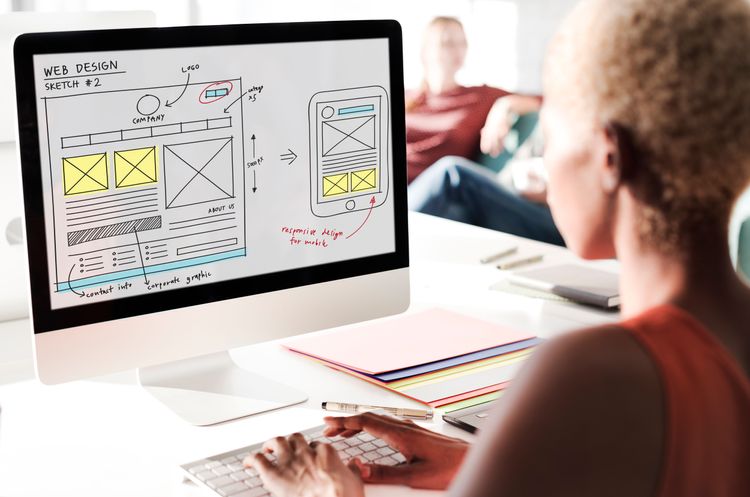In today's digital world, a well-designed website is crucial for business success. UX (user experience) and UI (user interface) design ensure that websites are user-friendly, visually appealing, and effective at converting visitors into customers.
UX design focuses on understanding user needs, while UI design handles the visual aspects like layout and color scheme. Together, they create functional and attractive products.
This article covers the basics of UX and UI design, the roles of designers, the importance of interface design, and tips for creating prototypes. Whether you're new to graphic design or an experienced UX/UI designer, you'll find valuable insights here. Let's dive in!
UI vs. UX Design: Key Differences
UI (User Interface) and UX (User Experience) design are crucial yet distinct aspects of web design that together shape the overall user experience. Understanding their differences is essential.
UI Design focuses on the visual layout of software and digital devices. It involves typography, colors, buttons, and other graphical elements, ensuring interfaces are visually appealing and easy to navigate.
UX Design centers on the overall user interaction experience. It aims to create seamless, enjoyable experiences that meet user needs through research, usability, accessibility, and interaction design.
While UI and UX have different focuses, they often overlap. Professionals in these fields may work across both areas, leading to the rise of UI/UX designers with combined skills. Collaboration between UI and UX designers ensures that visual elements and user experiences are harmonized, resulting in more effective digital products.

5 Tips to Improve UX/UI Design for Higher Conversions
1. Understand Your Audience and Their Needs
To create a successful digital product, it's crucial to understand your audience and their needs. UX (User Experience) design focuses on crafting enjoyable, efficient, and user-friendly experiences, while UI (User Interface) design deals with the visual aspects like layout, typography, and color schemes.
Start by conducting user research to gather insights about your target audience. Use methods such as interviews, surveys, and usability testing to identify their demographics, goals, and pain points. Create user personas - fictional representations of your target users - to guide your design decisions and ensure the product meets their expectations.
UX designers should use this data to inform design features and functionalities, while UI designers should create visually appealing interfaces that align with user preferences. Prototyping and iterative design are essential: build and test prototypes to identify usability issues and refine the product based on user feedback. This approach ensures a seamless, user-friendly experience that caters to your audience's needs.
2. Simplify Your Website's Navigation
Effective navigation is crucial for a seamless user experience. To simplify your website's navigation:
-
Organise Content: Structure content into clear, logical categories. Use descriptive labels for menu items to help users easily identify sections.
-
Consistent Menu Placement: Ensure the menu is consistently placed across all pages. Keep the design clean and straightforward for easy interaction.
-
Add a Search Bar: Improve navigation by including a search bar, making it easy for users to find specific information quickly. Ensure it is accessible and visible on all pages.
-
Test with Real Users: Conduct usability testing to gather feedback and identify areas for improvement. Use this data to refine and optimize navigation.
A well-designed navigation system enhances user satisfaction and reduces frustration, leading to better user retention and engagement.

3. Use Clear and Concise Language
Clear and concise language is crucial in UX/UI design to ensure users easily understand your website's content. Avoid technical jargon and complex terms that can confuse or alienate your audience. Instead, use simple, straightforward language to enhance user experience and increase conversions.
As a UX/UI designer, effective communication and visual design skills are essential. Present information in an aesthetically pleasing and easy-to-understand manner. Organize content logically through strong information architecture to help users quickly find what they need.
Tools like Adobe XD can assist in creating and refining prototypes for testing and iterating your designs. Engage in UX research to gather user feedback and make data-driven improvements, ensuring your website's language and overall user experience are optimised.
4. Optimise Your Website's Loading Speed
Improving your website's loading speed is crucial for enhancing user experience and reducing abandonment rates. Here are key strategies to optimise loading times:
- Compress Images and Videos: Reduce file sizes without compromising quality to speed up loading.
- Minimise Plugins and Scripts: Remove unnecessary plugins and scripts to streamline performance.
- Use a Content Delivery Network (CDN): Distribute content across multiple servers worldwide to reduce data travel distance and improve load times.
- Implement Caching: Use caching plugins or services to store versions of your website on users' devices for faster loading on subsequent visits.
By focusing on these aspects, you can create a seamless, fast-loading user experience that keeps users engaged and satisfied, ultimately driving conversions.

5. Use Visual Elements Strategically
Strategic use of visual elements is crucial in UX/UI design to enhance user experience and drive conversions. Here are key strategies:
-
High-Quality, Relevant Visuals: Use images and videos that support your content and brand. Ensure they are high-quality but avoid overuse to prevent slowing down your site.
-
Effective Use of White Space: Employ white space to create a clean, organized layout, helping users navigate your site easily and focus on essential elements.
-
Consistent Color and Typography: Select colors and fonts that align with your brand's personality. Consistent use of these elements enhances the professional appearance and appeal of your site.
Understanding the synergy between UI and UX design is essential. Combining thoughtful visual design with a user-centered approach creates a seamless and engaging experience, encouraging users to interact with your website.
In conclusion, to achieve a seamless and engaging UX/UI design experience, it is crucial to understand your audience, simplify navigation, use clear language, optimise loading speed, and strategically utilise visual elements while fostering collaboration between UI and UX designers.





